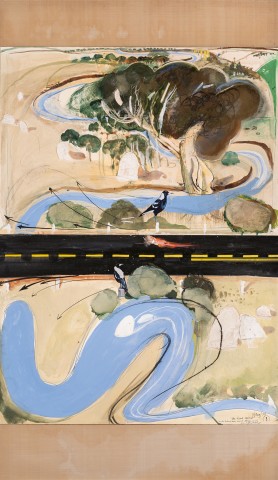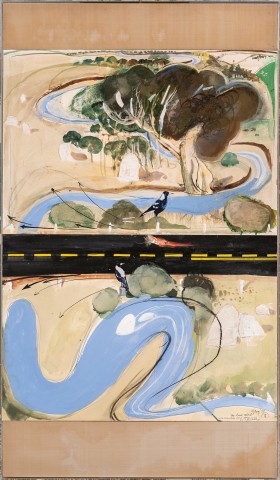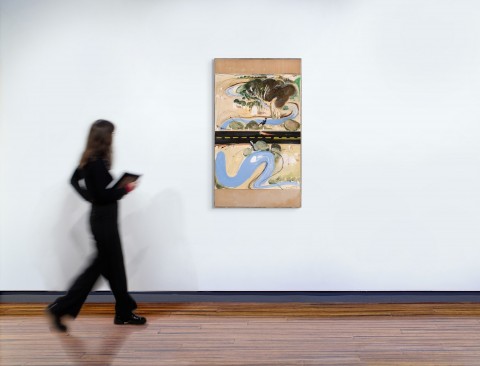THE DEAD RABBIT, 1979
BRETT WHITELEY
oil, Liquitex, gouache, charcoal, collage and hair on card on composition board with silk mounts in artist’s Perspex frame
132.0 x 74.5 cm
signed, stamped with initials, dated and inscribed with title lower right: 12 / Aug / 79 / ‘the dead rabbit’ / (on the Bathurst Road west of Oberon, N.S.W.) / brett Whiteley / BW
Robin Gibson Gallery, Sydney
Private collection, Sydney, acquired from the above in 1979
Brett Whiteley: Portraits: Crucifixions: (a paddock at) Oberon, David Reid’s Gallery (by Robin Gibson), Sydney, 26 April – 17 May 1980, cat. 28
Sutherland, K., Brett Whiteley: Catalogue Raisonné, Schwartz Publishing, Melbourne, 2020, cat. 139.79, vol. 7, p. 483
‘Of all the subjects Whiteley painted in his career, landscape gave him the greatest sense of release…’1
Awarded the prestigious Wynne Prize for Australian landscape painting in 1977, 1978 and 1984, Brett Whiteley possessed a universally admired talent for capturing the natural environment. As Barry Pearce elaborates, Nature offered Whiteley both inspiration and solace from the expectations of the art world and the unrelenting pressures he had come to experience in a life fuelled by creativity and addiction: ‘…if in many of his other themes Whiteley confronted the difficult questions of his psyche, landscape provided a means of escape, an unencumbered absorption into a painless, floating world.’2
Following a tumultuous decade abroad, in 1969 Brett Whiteley returned to Australia and, in the tradition of many expatriate artists before him, thus embarked upon an artistic pilgrimage to rediscover his homeland. Captivated afresh by the beauty, vastness and variety of the Australian landscape, he thus explored the shifting chromatic illusions and ‘optical ecstasy’ of Sydney’s Lavender Bay in sumptuous tableaux redolent of Matisse, before subsequently revisiting the country of his boyhood in the central west region of New South Wales. Indelibly embedded in his imagination, ‘the rounded, monumental, full-breasted hills and open spaces’3 that surrounded his boarding school in Bathurst had been not only an important impetus for his precocious endeavours, but an endless source of inspiration over the intervening decades. Equally influential were the compositions of Lloyd Rees which Whiteley had first admired at Macquarie Galleries one day after school – landscapes deeply poetic in their contemplation of soft curves and arabesques all rendered with impeccable tonality. As he later recalled, ‘…They contained nature and ideas, they contained naturalism but seemed also very invented, and the adventure of them was that they showed the decisions and revisions that had been made while they had been painted…’4
Characterised by restorative sojourns in the countryside (where the Whiteleys would invariably stay at the home of prominent radio host, John Laws, in Oberon, or Michael Hobbs in Carcoar), the late seventies thus witnessed the production of some of the most beautiful, serene landscapes of Whiteley’s career – aptly earning him the epithet of ‘chronologist of the golden paddocks, sensual hills and willow-strewn rivers of the central west.’5 Created during this halcyon period, notably The Dead Rabbit, 1979 was first unveiled in the artist’s highly acclaimed solo exhibition organised by Robin Gibson Galleries, Sydney in 1980 which juxtaposed lyrical pastorals immortalising the central west alongside Whiteley’s more tortured explorations of the Crucifixion theme featuring the ravaged body of his close friend and sculptor, Joel Elenberg, as the dying Christ. While ostensibly these landscapes were intended as a peaceful antidote to his darker, more painful musings, it could be argued that the present instead straddles both extremes of this complex duality. Indeed, amidst the exquisitely rendered passages of sensuous, sun-parched landscape here, complete with Whiteley’s graceful, gliding river, the intrusion of the road abruptly dividing the picture plane, together with the vivid, somewhat macabre depiction of roadkill (complete with collaged animal fur) hints at an underlying menace strikingly reminiscent of his turbulent, multi-panelled magnum opus Alchemy, 1972 – 73 (Art Gallery of New South Wales) conceived earlier that decade.
An impressive example from these pivotal years when the artist was arguably at the height of his creative powers and critical success, thus The Dead Rabbit encapsulates brilliantly the antithesis that so distinguished both Whiteley’s personality and his art; as Sandra McGrath elucidates, ‘…in truth he was living out one of his constant themes – good and evil, optimism and pessimism… all meshed into one overall psychological and pictorial design, one lifelong attempt to reconcile extremes, one eternal battle to identify the truth that E.M. Forster recognised as being accessible only by experiencing opposites.’6
1. Pearce, B., Brett Whiteley: Art and Life, Art Gallery of New South Wales, Sydney, 1995, p. 196
2. Ibid.
3. McGrath, S., Brett Whiteley, Bay Books, Victoria, 1979, p. 206
4. Whiteley cited in Klepac, L., Lloyd Rees – Brett Whiteley: On the Road to Berry, Heide Museum of Modern Art, Melbourne, 1993, p. 7
5. Hopkirk, F., Brett Whiteley 1958 – 1989: The Central West, Orange Regional Gallery, Orange, 1990
6. McGrath, op. cit., p. 94
VERONICA ANGELATOS


